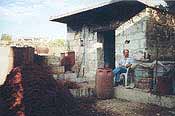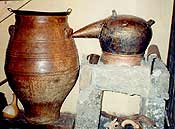

|
Folklore - Ancient crafts
|
|||
|
Raki production or kazánisma
|
|||
| Introduction | The social surroundings | The production |
| Having
experienced and read about other more or less joint working processes
going on in the villages of Crete, I must admit that I expected the
distillation of raki to include a lot of festivity, music and partying.
But the world of reality was quite different. In Chaniá and the other
bigger towns they have raki celebrations with music and free raki, but in
the villages nobody makes much of the distillation. Usually a small group
of people meet (each of them might have delivered the material for the
distillation i.e. the already pressed grapes: the mash (stráfylo) which is then being distilled). In all fairness I have to add, that
the two places where I attended the process were very small.
|
|
|
|
|
| Of
course not all Cretans distil raki in autumn. It is most definitely a
phenomenon, which takes place in the country, and even here only a few
people have a still (kazáni). Moreover,
you must have a personal licence issued by the
customs authorities every year. The licence follows the name of the one
who originally got it, but in practice it means, that one of the sons
takes over the work to avoid the paperwork of getting a new licence. In
addition to stating your personal data, you have to report the amount of
mash you have (and therefore pay tax on). As the licence moreover is
limited in time analogous to the mentioned amount of mash, it means a very
concentrated job for the producer. Unlike in Denmark the "snaps"
in Crete is taxed with only roughly 0,55 € per litre, but like everybody
else the Cretans do not like new taxes. It reminds me of the old Danish
expression "snaps of the pauper", an expression which long ago
has lost it's relevance. In this context you must remember that this tax
is fairly new. It was introduced for the first time in 1998 but rises
gradually every year. |
|
|
|
|
| At
the same time as it has become unprofitable for the small
"producer" to make his own raki, quite a few middle-sized
factories have come into existence. They produce large quantities of raki
for tourism and restaurants, but they often add to it different kinds of
additives or maybe even alcohol to keep a certain percentage. This
development means that the previous times, where you in merry company as a
matter of fact were able to consume considerable quantities of raki
without being hit by terrible hangovers the next day, are numbered. And
the taste of the new industrial product, I shall not comment on at all.
|
|
|
|
||